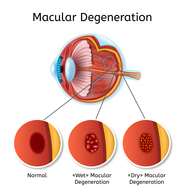Pharmacologic Activation of Autophagy without Direct mTOR Inhibition; a Therapeutic Strategy to Treat Dry Macular Degeneration
TECHNOLOGY NUMBER: 2020-502

OVERVIEW
Novel prevention and treatment of dry macular degeneration via pharmacologic activation of autophagy- Avoids direct inhibition of mammalian target of rapamycin (mTOR) and its deleterious effects on RBE
- An agent named flubendazole which reduces secretion of extracellular lipid-rich debris
BACKGROUND
Age-related macular degeneration (AMD) is the leading cause of blindness in the developed world. The pathogenesis of AMD is heralded by the accumulation of extracellular and intracellular lipid-rich debris within and around the retinal pigment epithelium (RPE). While the wet form of macular degeneration is characterized by fibrovascular scarring and can be prevented with anti-VEGF agents, the dry form of the disease affects 90% of AMD patients and does not have any known treatments. One potential treatment strategy involves the induction of autophagy, a conserved, intracellular catabolic, and degradative pathway which can clear the lipid-rich debris. However, inhibition of the mammalian target of rapamycin (mTOR) pathway, which is the major mechanism for inducing autophagy, can detrimentally alter core RPE functions. As such, a need exists for an alternative method to promote autophagy while sparing the RPE from any deleterious effects.
INNOVATION
Researchers have discovered a method for prevention and treatment of dry age-related macular degeneration through activation of autophagy without direct inhibition of the mammalian target of rapamycin (mTOR) pathway. The researchers initially studied over thirty putative autophagy inducers that do not act via direct mTOR inhibition, testing for safety and efficacy in a primary human RPE culture model of AMD. The most promising compound, flubendazole (FLBZ), reduced the secretion of lipoprotein particles that generate extracellular lipid-rich debris termed drusen. FLBZ also reduced accumulation of intracellular debris called lipofuscin, while concurrently stimulating production of hydroxybutyrate which is used by photoreceptor cells as an energy source. And, in contrast to direct mTOR inhibitors, these compounds preserved RPE-specific functions such as tight-junction integrity and outer segment phagocytosis. In summary, the inventors have discovered that a means by which to induce RPE autophagy outside of mTOR inhibition may serve as a promising approach for prevention and treatment of dry AMD.
-
expand_more mode_edit Inventor (6)David ZacksDebra ThompsonFeriel PresswallaJason MillerQitao ZhangRobin Ali
-
expand_more cloud_download Supporting documents (1)Product brochurePharmacologic Activation of Autophagy without Direct mTOR Inhibition; a Therapeutic Strategy to Treat Dry Macular Degeneration.pdf